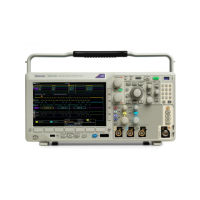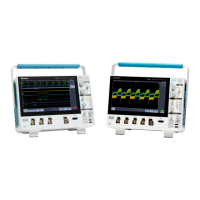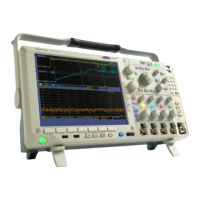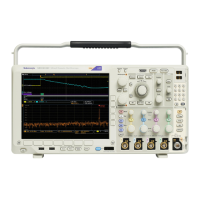Command Groups
4. RF Average tr
ace: Data from the RF Normal trace is averaged over multiple
acquisitions. This is true power averaging, which occurs before the log
conversion. Each power of 2 average reduces the displayed noise by 3 dB.
Time Domain Trace Types
The MDO4000/B/C offers three additional time domain trace types in addition to
the usual analog and digital waveforms one expects on an oscilloscope. On these
instruments, the time domain window can also display three RF time domain
traces derived from the time-domain I&Q data acquired for the RF input. Theyare
time-correlated with the analog and digital channels, and represent a continuous
time domain data stream. The time domain trace options are:
1. The RF Amplitude vs. Time trace: The instantaneous amplitude of the input,
after band-pass filtering, relative to the current frequency range (as definedbythe
center frequency and span settings.)
2. The RF Frequency vs. Time trace: The instantaneous frequency of the input,
relative to the center frequency. The vertical axis displays frequency. The
frequency versus time waveform handle (baseline indicator) indicates thecenter
frequency. When the trace is above the waveform handle, it is above the center
frequency. When the trace is below the waveform handle, it is below the center
frequency.
3. The RF Phase vs. Time trace: The instantaneous phase of the input, relative to
the center frequency. The vertical axis displays phase, with wrapping at roughly
+/- 180°.
The squelch function is used to suppress the phase and frequency information
when the amplitude of the RF input is below a user-specified value. This keeps
both the RF Frequency vs. Time and the RF Phase vs. Time traces from displaying
broad bands of noise when there is no signal present on the RF input.
Time-Correlated
Multi-Domain Display
(MDO4000/B and MDO4000C with option SA3 or SA6 only.)
A single trigger event coordinates acquisition across all analog, digital, and
RF inputs. This enables a time-correlated view of both the time and frequency
domain signals in a single instrument.
Spectrum Time: This is the period of time used to calculate the spectrum shown
in the frequency domain graticule.
Analog Time: This is the amount of time acquired in the time domain graticule.
RF Acquisition Time: This is the amount of time acquired by the RF system. At
mid-to-fast time base settings, it equals analog time. At slower time base settings,
it can be less than analog time.
Acquisition Stages
RF acquisitions travel through their own signal path before being digitized by the
oscilloscope. This signal path includes a combination of analog amplification,
2-48 MDO4000/B/C, MSO/DPO4000B and MDO3000 Series Oscilloscopes Programmer Manual

